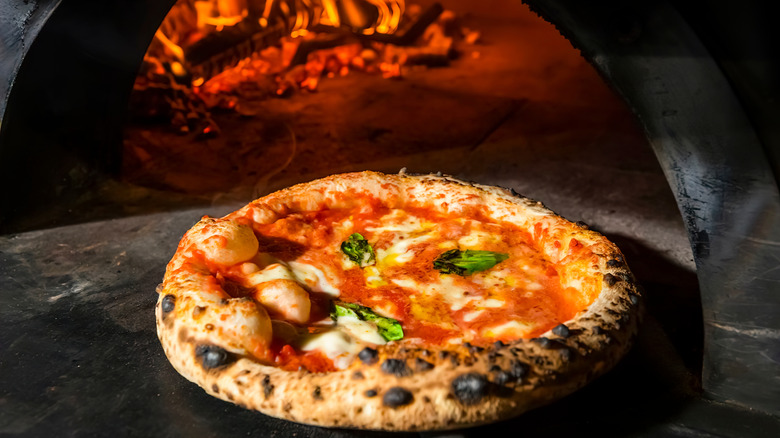The Pizza That Made Anthony Bourdain Rethink Everything He Knew About The Dish
Anthony Bourdain was never one to shy away from hot takes, especially when it came to food. While he often celebrated New York pizza– famously calling Brooklyn's Di Fara "the best of the best" in his 2005 Guardian guide — his travels to Naples made him question everything he thought he knew.
In a 2011 episode of No Reservations, Bourdain sat down at Pizzeria Pellone to try a classic margherita pizza, which is subject to strict standards for crust, ingredients, dimension, and temperature. As he explained, "In 2004, the Italian Ministry of Agriculture actually laid out regulations for how a Neapolitan pizza must be made." These Neapolitan pizzas are thus legally required to include slices of fresh mozzarella and thick, puffy crusts. Bourdain detailed how, in New York, most artisanal pizzas had thin, crisp crusts and used shredded, not fresh mozzarella.
Bourdain said that the Neapolitan usage of fresh mozzarella, which has a higher moisture content, can leak water into the crust, reducing the possible crispiness. Is this worth it? Apparently yes. "Whoa. Yes. Oh, that's pretty. That's beautiful," said the normally grumpy connoisseur. The moment was transformative. "Eating this throws into question everything I thought I knew about pizza. What does authentic pizza mean? What does it all mean? I don't know. I don't really even care. You know what? This is good."
What makes a Neapolitan pizza special
So, what is it that actually makes the Neapolitan pizza stand apart? First, its cultural weight: UNESCO designated the art of the Neapolitan pizzaiuolo as Intangible Cultural Heritage in 2017, recognizing its role in intergenerational local tradition.
This heritage is fiercely protected by the Associazione Verace Pizza Napoletana (AVPN), a body which enforces those strict rules on ingredients, preparation, and cooking. Pizzas must be cooked in under 90 seconds, remain soft and foldable, and include only authentic toppings like San Marzano tomatoes grown in Italy and fresh buffalo mozzarella, fresh basil, and olive oil. At the AVPN headquarters in Naples, aspiring pizzaioli from around the world train under exacting standards, while undercover "pizza spies" travel and taste pies to ensure compliance around the globe.
Interestingly, the origins of "pizza alla Napoletana" weren't savory at all. Early recipes from the 16th century, in fact, describe a Neapolitan dessert pie filled with almond custard, almost closer to ricotta tart. But with the colonization of the Americas and the influx of juicy tomatoes, the pie slowly transformed into the honored pizza we know today, and remained that way for generations. Bourdain himself, though fiercely loyal to New York slices, was forced to admit Naples had something unshakable. And while San Sebastián may have been his favorite travel destination overall, that single margherita in Naples sincerely rattled his rankings.


